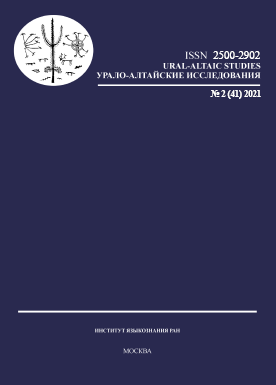НЕКОТОРЫЕ УТОЧНЕНИЯ К ИНТЕРПРЕТАЦИИ ДАННЫХ ОБДОРСКОГО НЕНЕЦКОГО СЛОВАРЯ. (ОТВЕТ НА СТАТЬЮ П. И. ЛИ «ГРАФИЧЕСКИЙ АНАЛИЗ ВОКАЛИЗМА ПЕРВОГО СЛОГА В НЕНЕЦКИХ СЛОВАРЯХ ИЗ АРХИВА А. М. ШЁГРЕНА» // УАИ, 1 (40), 2021. С. 47—60)
SOME CLARIFICATIONS TO THE INTERPRETATION OF THE DATA OF THE OBDORSK NENETS DICTIONARY (REPLY TO THE ARTICLE OF P. I. LI “THE GRAPHIC ANALYSIS OF THE FIRST SYLLABLE VOWEL SYSTEM IN NENETS DICTIONARIES FROM A. M. SJÖGREN’S ARCHIVE” // URAL-ALTAIC STUD
Author(s): Ilya B. Itkin, Svetlana I. PereverzevaSubject(s): Theoretical Linguistics, Phonetics / Phonology, Lexis, Comparative Linguistics, Finno-Ugrian studies
Published by: Институт языкознания Российской академии наук
Keywords: Nenets language; Obdorsk Nenets dictionary; Yamal dialect; stress; nasal prosthetic consonant; vocal anlaut; A. M. Sjögren;
Summary/Abstract: The article contains some clarifications to the interpretation of the data of the Obdorsk Nenets Dictionary (Ob) proposed in [Li 2021]. In the first part of the article, we show that the acute and grave marks were used in Ob to denote stress, and we provide a description of the accent system of the monument. Comparison of the accentuation of two-syllable names in Ob with the data of the Yamal dialect suggests that the placement of accent marks in the dictionary reflects a certain phonetic reality. The second part is devoted to the use of the prosthetic consonant graphemes (n, nj, ng, m, g) in Ob. The graphemes n and nj reflect the palatal *ń-, which appears before the original front vowels; the graphemes ng, as well as t (only in mum ‘grass’) and g (only in gyn ‘bow’) reflect the velar *ŋ- and appear before the back vowels. This rule was formulated in the article [Hajdú 1954]. In Ob, several words with an initial back vowel do not have a prosthesis, cf. amsà ‘meat’ vs. ngob ‘one’, udà ‘hand’ vs. ngaiwa ‘head’. We suggest that the prosthetic consonant appears if the first syllable is stressed. We also consider the Ustyinsky dialect, which is another rare example of the Nenets dialect with the ŋ- ~ Ø variation. The plausible hypothesis is that in this dialect, ŋ- is presented in non-derivative verbs, and Ø is presented in other cases, cf. ŋа̯m˛Dzrəˬ ‘to eat’ vs. а̯m˛Dzɒ̱ ‘meat’. The existence of “ŋ-less” dialects mentioned in [Hajdú 1954] and of such “hybrid” idioms as the Ob and Ustyinsky dialect presumably cannot be explained by the secondary loss of *ŋ-; thus, in Nenets words with initial ŋ- both for Proto-Nenets and even for Proto-Tundra Nenets, the vocal, but not the nasal, anlaut should be reconstructed.
Journal: Урало-алтайские исследования
- Issue Year: 2021
- Issue No: 02 (41)
- Page Range: 145-154
- Page Count: 10
- Language: Russian

